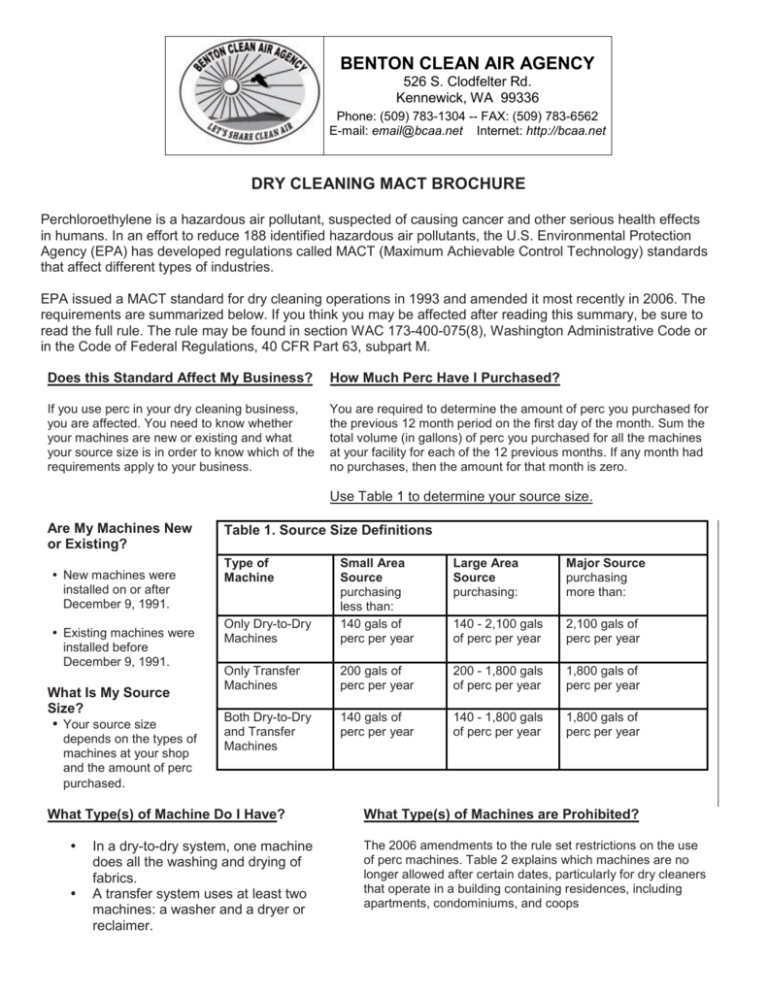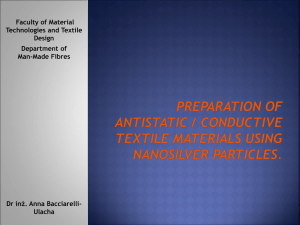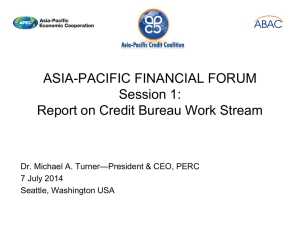Perchloroethylene is a hazardous air pollutant, suspected of causing
advertisement

BENTON CLEAN AIR AGENCY 526 S. Clodfelter Rd. Kennewick, WA 99336 Phone: (509) 783-1304 -- FAX: (509) 783-6562 E-mail: email@bcaa.net Internet: http://bcaa.net DRY CLEANING MACT BROCHURE Perchloroethylene is a hazardous air pollutant, suspected of causing cancer and other serious health effects in humans. In an effort to reduce 188 identified hazardous air pollutants, the U.S. Environmental Protection Agency (EPA) has developed regulations called MACT (Maximum Achievable Control Technology) standards that affect different types of industries. EPA issued a MACT standard for dry cleaning operations in 1993 and amended it most recently in 2006. The requirements are summarized below. If you think you may be affected after reading this summary, be sure to read the full rule. The rule may be found in section WAC 173-400-075(8), Washington Administrative Code or in the Code of Federal Regulations, 40 CFR Part 63, subpart M. Does this Standard Affect My Business? How Much Perc Have I Purchased? If you use perc in your dry cleaning business, you are affected. You need to know whether your machines are new or existing and what your source size is in order to know which of the requirements apply to your business. You are required to determine the amount of perc you purchased for the previous 12 month period on the first day of the month. Sum the total volume (in gallons) of perc you purchased for all the machines at your facility for each of the 12 previous months. If any month had no purchases, then the amount for that month is zero. Use Table 1 to determine your source size. Are My Machines New or Existing? New machines were installed on or after December 9, 1991. Existing machines were installed before December 9, 1991. What Is My Source Size? Your source size depends on the types of machines at your shop and the amount of perc purchased. Table 1. Source Size Definitions Type of Machine Large Area Source purchasing: Major Source purchasing more than: Only Dry-to-Dry Machines Small Area Source purchasing less than: 140 gals of perc per year 140 - 2,100 gals of perc per year 2,100 gals of perc per year Only Transfer Machines 200 gals of perc per year 200 - 1,800 gals of perc per year 1,800 gals of perc per year Both Dry-to-Dry and Transfer Machines 140 gals of perc per year 140 - 1,800 gals of perc per year 1,800 gals of perc per year What Type(s) of Machine Do I Have? In a dry-to-dry system, one machine does all the washing and drying of fabrics. A transfer system uses at least two machines: a washer and a dryer or reclaimer. What Type(s) of Machines are Prohibited? The 2006 amendments to the rule set restrictions on the use of perc machines. Table 2 explains which machines are no longer allowed after certain dates, particularly for dry cleaners that operate in a building containing residences, including apartments, condominiums, and coops Table 2. Prohibited Machines Type of Machine When Transfer machines No new machines installed after September 22, 1993. Remove all existing machines by July 28, 2008, except for those installed prior to September 22, 1993 at small area sources. All perc machines located in a building with a residence If installed before December 21, 2005, a perc machine may be used until it wears out but not beyond December 21, 2020. Requirements for all Machines All dry cleaners affected by this regulation need to comply with the following requirements: Recordkeeping: Keep an operations and maintenance record available upon request, and keep it for five years. The enclosed charts can help organize this information, which must include the following: If installed on or after December 21, 2005 but before July 13, 2006, a perc machine may only be used when: • enclosed inside a vapor barrier with its exhaust system operating at all times the dry cleaning machine operates and during maintenance, • the door to the vapor barrier enclosure is only open when a person is entering or leaving, and • the machine has a refrigerated condenser and carbon adsorber (also called a “generation 4” machine). Such perc machines may not be used after July 27, 2009. No new perc machines installed after July 13, Route the PCE gas/vapor from the dry cleaning system through the applicable equipment in Table 3: Inspection: date and result of each inspection. Repair: date, time, and result of each repair. Refrigerated Condenser monitoring information (details follow) Carbon Adsorber monitoring (details follow) Perc purchases: Keep perc purchase receipts to determine consumption amounts. Perc Usage: On the first business day of each month, record how much perc you bought in the prior month, based on receipts. Also, keep a running record of your annual amount of perc consumption. Operations and Maintenance: Table 3: Minimum PEC Vapor Vent Control Requirements: Small Area Source Large Area Source Major Source Refrigerated condenser for all machines installed after September 21, 1993 Refrigerated condenser for all machines Refrigerated condenser with a carbon adsorber for all machines installed after September 21, 1993 Keep all perchloroethylene and wastes containing PCE in closed, non-leaking containers. Drain cartridge filters in their housing or sealed containers for at least 24 hours. Keep machine doors closed, unless loading and unloading fabrics. Operate and maintain equipment according to the manufacturer’s instructions, and keep the owner’s manual on-site. Keep a copy on site of the design specifications and operating manuals for all dry cleaning equipment Keep a copy on site of the design specifications and operating manuals for all emissions control devices New Requirements for All Machines; These new requirements apply following amendments to the rule that became effective in July 2006; required of all machines by July 28, 2008: Required of all machines: Inspection and Leak Detection: Perceptible Leaks: Inspection and Leak Detection: With halogenated hydrocarbon detector or perchloroethylene gas analyzer: performed regularly, and a written log of leak inspections must be kept. At small area sources, you need to conduct inspections biweekly (once every two weeks), while large area sources and major sources must perform inspections once a week while the system is operating The leak inspection must include: Inspect all components listed above for vapor leaks monthly while the component is in operation. Use either a halogenated hydrocarbon detector or perchloroethylene gas analyzer. A vapor leak means a perc vapor concentration exceeding 25 parts per million by volume (50 parts per million by volume as methane), as indicated by one of these instruments. To measure a vapor leak, place the probe of the instrument at the surface (1/2 inch from component) of the component interface where leakage could occur and move it slowly (about one inch per second) along the periphery. Major sources must perform the monthly vapor leak inspections using a perc gas analyzer according to EPA Method 21. Conducting a vapor leak inspection can replace one weekly/biweekly inspection for perceptible leaks for that month. A leak detection and repair program must be Hose and pipe connections, fittings, couplings and valves Door gasket seating Filter gaskets and seating Pumps Solvent tanks and containers Water separators Muck cookers Stills Exhaust dampers Diverter valves Cartridge filter housings If you find leaks, repair them within 24 hours. If you need repair parts: What if My Source Size Changes? Any time you install a machine, you should determine your source size at that time and every month thereafter to see which requirements apply to that machine. Follow the calculation outlined above under “How Much Perc Have I Purchased?” Some important things to remember as your source size changes: Requirements for any machine can never be reduced, even if you purchase less perc. If you lower your yearly perc consumption, any machine installed during times of lower yearly perc consumption could benefit from reduced requirements. If you increase your yearly perc consumption and your source size changes, you must comply with any additional requirements within 180 days and submit a new Notification of Compliance Status form to the EPA within 210 days. Order them within two days; Install parts within five days of receipt; Keep a written log of repair work, including the day parts were ordered, received and installed. Keep all records for a minimum of five years. Use the enclosed charts for assistance Refrigerated Condensers monitoring Requirements The following monitoring and record keeping requirements apply to refrigerated condensers: The refrigerated condenser on a dry-to-dry machine must not release perc vapors into the atmosphere while the drum is rotating. To ensure this, the perc vapors should be recirculated back through the machine in a closed loop system so the vapor stream will pass through the refrigerated condenser several times. Carbon Adsorber monitoring requirements The following monitoring and record keeping requirements apply to carbon adsorbers: The carbon adsorber must not be bypassed to vent or release any perc vapors to the atmosphere. The concentration of perc in the carbon adsorber exhaust must be measured and record with a colorimetric detector tube once per week. If a refrigerated condenser on a dry-to-dry machine pulls air through the door when the door is opened after the cycle, then it must have a diverter valve. The diverter valve requirement only applies to vented dry cleaning machines. Nonvented (closed loop) machines do not need diverter valves. The measurement must be taken at the end of the last dry cleaning cycle prior to desorption. The perc concentration must be 100 ppm (parts per million) or less while the dry cleaning machine is venting to the carbon adsorber at the end of the last dry cleaning cycle prior too desorption of the carbon adsorber A refrigerated condenser on a washer must not release perc vapors into the atmosphere until the door is opened. If the concentration is greater than 100 ppm, make repairs or adjustments and keep records of your actions. Monitor the refrigeration system’s high pressure and low pressure once per week during the drying phase to determine if they are in the range specified in the manufacturer’s operating instructions. If the machine is not equipped with refrigeration system pressure gauges, then follow the temperature monitoring. The colorimetric tube must be operated according to the manufacturer’s instructions and with an accuracy of ± 25 ppm per volume. if the dry cleaning system does not have a permanent colorimetric tube, a sampling port must be provided within the exhaust outlet of the carbon adsorber. it must meet these requirements: Once per week, you must measure and record the exhaust temperature on the outlet side of the refrigerated condenser. The temperature must be less than or equal to 45°F. If the temperature exceeds 45°F, make repairs or adjustments and keep records of your actions. The temperature sensor used must be operated according to the manufacturer’s instructions and have an accuracy of ± 2°F. If a refrigerated condenser is used on a washer, you must measure and record the temperature of the washer exhaust on both the inlet and the outlet side of the condenser once per week. The temperature difference between the inlet and outlet must be 20°F or greater. The temperature sensor must be operated according to the manufacturer’s instructions and have an accuracy of ± 2°F. If the temperature difference is less than 20°F, make repairs or adjustments and keep records of your actions. a sampling port in the exhaust outlet must be easily accessible and at a point equivalent to at least eight duct diameters downstream and at least two duct diameters upstream from any flow disturbance (i.e., a bend, expansion, contraction or outlet). If you use a supplemental carbon adsorber and the perc vapor passes through the device before the door is opened, you must measure and record the perc concentration within the drum at the end of the dry cleaning cycle with a colorimetric detector tube once per week. The perc concentration must be 300 ppm or less when measured by inserting the colorimetric detector tube into the open space above the articles at the rear of the drum immediately upon opening the door. If the concentration is greater than 300 ppm, make repairs or adjustments and keep records of your actions. The colorimetric tube must be operated according to the manufacturer’s instructions and with an accuracy of ± 75ppm per volume. What are the Different Record Keeping and Notification Requirements I Must Meet? To help you comply with these requirements, most record keeping needs are included in the enclosed charts. Carbon Adsorber Weekly Perc Concentration Log—When used to comply with the rules on a dry to- dry machine, dryer or reclaimer, measure and record the following parameters: Measure and record the concentration of perc in the adsorber exhaust duct while the machine is venting to the adsorber at the end of the last dry cleaning cycle prior to desorption to determine if the concentration is greater than 100 ppm immediately upon machine door opening. Measure and record the concentration of perc in the dry cleaning machine drum at the end of the dry cleaning cycle to determine if the concentration is less than or equal to 300 ppm prior to machine door opening. Fill out a corrective action report if either location measures above the indicated concentration Permit Application—All perc dry cleaners should have submitted a General Operation Permit application, or must do so before installing any new equipment. Perc Consumption Record—All dry cleaners need to record their monthly and annual consumption of perchloroethylene. (Use the chart!) Leak Detection Inspection Log— The inspection can be done by sight, smell or feel of air flow or perc and must include a check of the areas described previously. All observations and repairs must be recorded in a log. (Use the chart!) Corrective Action Report—If leaks are found, or monitoring levels for control devices exceed their limits, you must record the date the problem was detected and the date parts were ordered, received and installed. Refrigerated Condenser Weekly Monitoring— When used to comply with the rules on a dry-to-dry machine, dryer or reclaimer, measure and record the following parameters: Measure the refrigeration system high pressure and low pressure during the drying phase to determine if they are in the range specified by the manufacturer. If the machine is not equipped with refrigeration system pressure gauges, then measure the temperature on the outlet side of the refrigerated condenser. The temperature must be less than or equal to 45°F and, if not, a corrective action report must be completed. (Use the chart!) For a washer, you must measure the temperature of the vapor entering and exiting a refrigerated condenser and record the difference. The difference between the inlet and outlet temperature must be greater than 20°F and, if not, a corrective action report must be completed. Notification of Compliance Status— A Notification of Compliance Status Report is due to EPA by July 28, 2008 for all the new requirements under the amendments in 2006. For all new machines, the report is due 30 days after the machine is installed. Please also send a copy to the BCAA.






